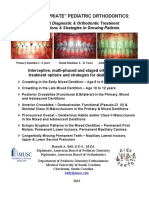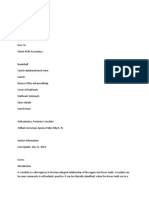Vertical Discrepancies and Their Treatment
Vertical Discrepancies and Their Treatment
Uploaded by
Kajal Panchal19951995Copyright:
Available Formats
Vertical Discrepancies and Their Treatment
Vertical Discrepancies and Their Treatment
Uploaded by
Kajal Panchal19951995Original Title
Copyright
Available Formats
Share this document
Did you find this document useful?
Is this content inappropriate?
Copyright:
Available Formats
Vertical Discrepancies and Their Treatment
Vertical Discrepancies and Their Treatment
Uploaded by
Kajal Panchal19951995Copyright:
Available Formats
Introduction
1. INTRODUCTION
The orthodontic literature and the orthodontic lecture circuit are replete with
publications and much discussion pertaining to treatment of the anteroposterior dimension
and to a lesser extent the transverse dimension of the dentition. However, there has been
very little discussion and much less compilation of the work on development or treatment
of the vertical dimension.
Probably no discipline in medicine and certainly none in dentistry devote more time
to growth research than orthodontics. The amazing benefits of this growth to the clinician
have been well-documented by researchers since the 18th century. Yet equally conspicuous
is the fact that this fantastic wealth of information is still consigned to the laboratory and
for the most part is ignored by the clinician. How else can one explain the continued
rampant use of extraction therapy in growing children, serial extraction in children with
great growth potential, the increasing use of orthognathic surgery in younger patients and
the prevalent notion that the vertical dimension is one of orthodontics’ greatest challenges.1
In reality the vertical dimension should be the easiest of the three dimensions for
the orthodontist to deal with. It grows the most in magnitude and for the longest period of
time. It would seem that the greater the potential for a structure to increase in size, the
greater the opportunity to effect a change in that structure. And the longer potential for
change, the longer the opportunity to make that change.
Why has the vertical dimension been such an enigma? It would seem that the
answer is also to be found in the literature. A perusal of same would indicate that, for the
most part in the past and still to a large extent in the present, traditionally the vertical
dimension has been largely ignored! And when finally discovered, the most commonly
used mechanics are frequently totally contrary to biological needs.
This work will unravel the classification, diagnosis and how to manage the vertical
discrepancies at different ages and dentition in Orthodontics.
According to Thomas Rakosi1, there are various factors, which give importance to
a malocclusion with a vertical discrepancy. While treating a case of Open bite or Deep bite,
it is not only the vertical dimensions that need to be addressed, but also the sagittal
relationship, i.e., anteroposteriorly, if it is a Class I, Class II, or Class III malocclusion. The
direction & amount of growth completed, and growth expected in the patient during the
course of the treatment and in the post-treatment period is to be considered as well.
The vertical dimension is unique in that the growth rate is highest and lasts the
longest in this direction. Since growth tends to increase the vertical distance between the
maxillary and mandibular jaw bases, performing treatment during this period is most
advantageous, as stated by Rakosi.1
Vertical Discrepancies and their Treatment 1
Introduction
However, he also states that vertical dimension is not stable. Even in adults who
have never had any orthodontic treatment, significant changes can occur in the vertical
dimension. Abrasion or loss of teeth can close down the vertical dimension leading to a
deep bite. Tooth elongation or over-eruption also can occur, increasing the vertical
dimension and opening the bite. The stability of tooth position depends on the eruption or
elongation tendency of the teeth and on the opposing forces. If the occlusal forces are
altered, the equilibrium is disturbed and the teeth migrate in the direction of the occlusal
plane.1
Late growth of the mandible may increase an already existing increase in vertical
dimension, accentuating the malocclusion thus occurring due to the discrepancy.
Now talking about the vertical dental relationships its important to understand the
normal relationship i.e. normal overbite and then understand its discrepancy i.e. Open bite
and deep bite.
According to Profitt2, Overbite is defined as the vertical overlap of the incisors
(Fig-1.1)
Fig 1.1 Vertical overlap of incisors
Normally the lower incisor edges contact the lingual surface of the upper incisors
at or above the cingulum. i.e., normally there is 1-2mm overbite. (Fig-1.2)
Vertical Discrepancies and their Treatment 2
Introduction
Fig 1.2: Normal overbite.
Overbite is explained as the percentage of the mandibular incisor crown, that is
overlapped vertically by the maxillary incisors, when the teeth are in centric occlusion.2
Centric occlusion is the vertical and horizontal position of the mandible in which the cusps
of the maxillary and mandibular teeth interdigitate maximally. Overbite values range from
zero to more than 100%. The mean values of overbite in a Caucasian population with
normal occlusion are 45% +/-20% for males and 36% +/-13% for females. Vertical
relationships may also vary greatly between racial groups. Deep-bite is usually more
prevalent than open bite. Anterior open bites occur more often than posterior open bites.
However, this is a gross estimation and a detailed epidemiological estimation will be
presented sequentially.2
Deep bite
Definition-According to Moyers3, a deep-bite exists when the mandibular incisors
impinge on the palatal mucosa. In (Fig-1.3), the circled area shows excessive impingement
of the mandibular incisal edge on the palatal mucosa. This malocclusion is restricted to the
anterior teeth alone.
Fig 1.3: Deep bite
Vertical Discrepancies and their Treatment 3
Introduction
Open bite
Definition-According to Subtelney and Sakuda4, open bite is defined as an open
vertical dimension between the incisal edges of the maxillary and mandibular anterior
teeth. In a case of openbite, there will not be any vertical overlap. To measure the amount
of bite opening-the vertical separation is measured. To diagnose-the vertical distance
between the maxillary and the mandibular incisor edges are measured. In Fig-1.4, there is
no overlap of incisal edges, showing a bite that has opened up.
Fig 1.4: Open bite
Vertical Discrepancies and their Treatment 4
You might also like
- THE ORTHODONTIC ROADMAP: GUIDELINES FOR THE DIAGNOSIS AND TREATMENT OF ORTHODONTIC MALOCCLUSIONSFrom EverandTHE ORTHODONTIC ROADMAP: GUIDELINES FOR THE DIAGNOSIS AND TREATMENT OF ORTHODONTIC MALOCCLUSIONS5/5 (1)
- Basic Nutrition and Diet Therapy (Sue Rodwell Williams)100% (2)Basic Nutrition and Diet Therapy (Sue Rodwell Williams)1,231 pages
- Periodontal Treatment of Excessive Gingival DisplayNo ratings yetPeriodontal Treatment of Excessive Gingival Display12 pages
- Y 5 Lec 1- Deep Bite- Ali Al-Bustani 2024No ratings yetY 5 Lec 1- Deep Bite- Ali Al-Bustani 20246 pages
- Orthodontics 1st Leture Difinitions 2021No ratings yetOrthodontics 1st Leture Difinitions 202156 pages
- Management of Deepbite Malocclusion: by Assist. Prof. Dr. Hadi M IsmailNo ratings yetManagement of Deepbite Malocclusion: by Assist. Prof. Dr. Hadi M Ismail68 pages
- Age Appropriate Orthodontics Overview HO 2013No ratings yetAge Appropriate Orthodontics Overview HO 201331 pages
- Orthodontic and Peadiatric Dentistry - COLOUR GUIDE 2000100% (7)Orthodontic and Peadiatric Dentistry - COLOUR GUIDE 2000172 pages
- Adult Transverse Diagnosis and Treatment A Case Ba - 2019 - Seminars in Orthodo100% (1)Adult Transverse Diagnosis and Treatment A Case Ba - 2019 - Seminars in Orthodo40 pages
- Open Bite, A Review of Etiology and Manageme PDFNo ratings yetOpen Bite, A Review of Etiology and Manageme PDF8 pages
- Class II and Class III Jaw Relations (1)No ratings yetClass II and Class III Jaw Relations (1)11 pages
- Classification of Malocclusion GALLOIS 06 Final - BWNo ratings yetClassification of Malocclusion GALLOIS 06 Final - BW12 pages
- Orthodontic-treatment-of-multiple-impacted-teeth-iNo ratings yetOrthodontic-treatment-of-multiple-impacted-teeth-i13 pages
- Handbook of Molecular Biotechnology Aug 12 2024 _ 0367517876 _ CRC Press 1st Edition Dongyou Liu All Chapters Instant Download100% (4)Handbook of Molecular Biotechnology Aug 12 2024 _ 0367517876 _ CRC Press 1st Edition Dongyou Liu All Chapters Instant Download24 pages
- Medical Record Department: Ravi Bagali Jayendra Tripati Amrithayan Das Shivaram Gaurav RaviNo ratings yetMedical Record Department: Ravi Bagali Jayendra Tripati Amrithayan Das Shivaram Gaurav Ravi61 pages
- Ordinance Granting Financial Assistance To Sari BHWS and TanodsNo ratings yetOrdinance Granting Financial Assistance To Sari BHWS and Tanods3 pages
- Ra-042355 Professional Teacher - Secondary (English) Zamboanga 10-2022No ratings yetRa-042355 Professional Teacher - Secondary (English) Zamboanga 10-202241 pages
- Pharmaceutical Inorganic Chemistry: Unit 3, Chapter 5: Dental Products ScopeNo ratings yetPharmaceutical Inorganic Chemistry: Unit 3, Chapter 5: Dental Products Scope1 page
- ID Perbandingan Kadar Hba1c Pada Pasien DMNo ratings yetID Perbandingan Kadar Hba1c Pada Pasien DM5 pages
- Curriculum Vitae Mutlu Ozcan Academia 20No ratings yetCurriculum Vitae Mutlu Ozcan Academia 201 page
- 06 - Adi Utomo Hatmoko, Ar., M.Arch., IAI., AA - Konsep Redesain Kelas Rawat InapNo ratings yet06 - Adi Utomo Hatmoko, Ar., M.Arch., IAI., AA - Konsep Redesain Kelas Rawat Inap90 pages
- AIMIX - Provention Manual For Coronavirus Pneumonia PDFNo ratings yetAIMIX - Provention Manual For Coronavirus Pneumonia PDF14 pages
- 4812 Volume 10 Transmission Based Precautions Isolation Guidelines PDFNo ratings yet4812 Volume 10 Transmission Based Precautions Isolation Guidelines PDF29 pages
- State of Interprofessional Education in Oman and in The Middle EastNo ratings yetState of Interprofessional Education in Oman and in The Middle East21 pages
- MODULE 3 STUDENT National Patient Safety Goals 2013100% (1)MODULE 3 STUDENT National Patient Safety Goals 201315 pages
- Scoping Report: Financing Primary Health Care in IndiaNo ratings yetScoping Report: Financing Primary Health Care in India23 pages
- OLUWATIMILEYIN-ANGEL-ADEDIJI-FlowCV-Resume-20240301 (1) (1) (1)No ratings yetOLUWATIMILEYIN-ANGEL-ADEDIJI-FlowCV-Resume-20240301 (1) (1) (1)3 pages
- Meganeuron OD Plus Capsule - View Uses, Side Effects, Price and Substitutes - 1mgNo ratings yetMeganeuron OD Plus Capsule - View Uses, Side Effects, Price and Substitutes - 1mg4 pages
- Transforming Biomarker Data Into An SDTM Based DatasetNo ratings yetTransforming Biomarker Data Into An SDTM Based Dataset7 pages
- MCQs in Oral Surgery: A comprehensive reviewFrom EverandMCQs in Oral Surgery: A comprehensive review
- THE ORTHODONTIC ROADMAP: GUIDELINES FOR THE DIAGNOSIS AND TREATMENT OF ORTHODONTIC MALOCCLUSIONSFrom EverandTHE ORTHODONTIC ROADMAP: GUIDELINES FOR THE DIAGNOSIS AND TREATMENT OF ORTHODONTIC MALOCCLUSIONS
- Basic Nutrition and Diet Therapy (Sue Rodwell Williams)Basic Nutrition and Diet Therapy (Sue Rodwell Williams)
- Periodontal Treatment of Excessive Gingival DisplayPeriodontal Treatment of Excessive Gingival Display
- Management of Deepbite Malocclusion: by Assist. Prof. Dr. Hadi M IsmailManagement of Deepbite Malocclusion: by Assist. Prof. Dr. Hadi M Ismail
- Orthodontic and Peadiatric Dentistry - COLOUR GUIDE 2000Orthodontic and Peadiatric Dentistry - COLOUR GUIDE 2000
- Adult Transverse Diagnosis and Treatment A Case Ba - 2019 - Seminars in OrthodoAdult Transverse Diagnosis and Treatment A Case Ba - 2019 - Seminars in Orthodo
- Classification of Malocclusion GALLOIS 06 Final - BWClassification of Malocclusion GALLOIS 06 Final - BW
- Orthodontic-treatment-of-multiple-impacted-teeth-iOrthodontic-treatment-of-multiple-impacted-teeth-i
- Principles of Design and Fabrication in ProsthodonticsFrom EverandPrinciples of Design and Fabrication in Prosthodontics
- Orthodontic and Surgical Management of Impacted TeethFrom EverandOrthodontic and Surgical Management of Impacted Teeth
- Handbook of Molecular Biotechnology Aug 12 2024 _ 0367517876 _ CRC Press 1st Edition Dongyou Liu All Chapters Instant DownloadHandbook of Molecular Biotechnology Aug 12 2024 _ 0367517876 _ CRC Press 1st Edition Dongyou Liu All Chapters Instant Download
- Medical Record Department: Ravi Bagali Jayendra Tripati Amrithayan Das Shivaram Gaurav RaviMedical Record Department: Ravi Bagali Jayendra Tripati Amrithayan Das Shivaram Gaurav Ravi
- Ordinance Granting Financial Assistance To Sari BHWS and TanodsOrdinance Granting Financial Assistance To Sari BHWS and Tanods
- Ra-042355 Professional Teacher - Secondary (English) Zamboanga 10-2022Ra-042355 Professional Teacher - Secondary (English) Zamboanga 10-2022
- Pharmaceutical Inorganic Chemistry: Unit 3, Chapter 5: Dental Products ScopePharmaceutical Inorganic Chemistry: Unit 3, Chapter 5: Dental Products Scope
- 06 - Adi Utomo Hatmoko, Ar., M.Arch., IAI., AA - Konsep Redesain Kelas Rawat Inap06 - Adi Utomo Hatmoko, Ar., M.Arch., IAI., AA - Konsep Redesain Kelas Rawat Inap
- AIMIX - Provention Manual For Coronavirus Pneumonia PDFAIMIX - Provention Manual For Coronavirus Pneumonia PDF
- 4812 Volume 10 Transmission Based Precautions Isolation Guidelines PDF4812 Volume 10 Transmission Based Precautions Isolation Guidelines PDF
- State of Interprofessional Education in Oman and in The Middle EastState of Interprofessional Education in Oman and in The Middle East
- MODULE 3 STUDENT National Patient Safety Goals 2013MODULE 3 STUDENT National Patient Safety Goals 2013
- Scoping Report: Financing Primary Health Care in IndiaScoping Report: Financing Primary Health Care in India
- OLUWATIMILEYIN-ANGEL-ADEDIJI-FlowCV-Resume-20240301 (1) (1) (1)OLUWATIMILEYIN-ANGEL-ADEDIJI-FlowCV-Resume-20240301 (1) (1) (1)
- Meganeuron OD Plus Capsule - View Uses, Side Effects, Price and Substitutes - 1mgMeganeuron OD Plus Capsule - View Uses, Side Effects, Price and Substitutes - 1mg
- Transforming Biomarker Data Into An SDTM Based DatasetTransforming Biomarker Data Into An SDTM Based Dataset

























































































